 W
WAeclanum was an ancient town of Samnium, southern Italy, about 25 km east-southeast of Beneventum, on the Via Appia. It lies in Passo di Mirabella, near the modern Mirabella Eclano.
 W
WAmcotts Moor Woman is the name given to a bog body discovered in 1747 in a bog near Amcotts, Lincolnshire, England, who lived sometime between A.D. 200 and 400.
 W
WAta is the common name given to the 6-inch (15 cm) long skeletal remains of a human fetus found in 2003 in a deserted Chilean town in the Atacama Desert. DNA analysis done in 2018 on the premature human fetus identified unusual mutations associated with dwarfism and scoliosis, though these findings were later disputed. The remains were found by Oscar Muñoz, who later sold them; the current owner is Ramón Navia-Osorio, a Spanish businessman.
 W
WThe Birka female Viking warrior was a woman buried with the accoutrements of an elite professional Viking warrior in a 10th century chamber-grave in Birka, Sweden. Thought to be a male warrior since the grave's excavation in 1889, the remains have been proved to be female by both osteological analysis and a DNA study in 2017. The study concludes the artifacts buried with the woman are evidence she was a high-ranking professional warrior. That conclusion has been disputed as premature by some archaeologists and historians who say the bones and artifacts are not evidence that women were warriors in patriarchal Viking culture. This controversy has contributed to the debate about the role of women in Viking society.
 W
WCashel Man is a bog body from a bog near Cashel in County Laois, Ireland. He was found on 10 August 2011 by Bord na Móna employee Jason Phelan from Abbeyleix. The body was a young adult male, around 20–25, who had been intentionally covered with peat after death. The crouched figure was recovered after being partially damaged by a milling machine in 2011. The head and left arm were presumed destroyed by the peat harvester, until later recovered.
 W
WCharlie is the name given to a Neolithic skeleton of a three-year-old child found near the ancient stone circle of Avebury, Wiltshire, England. Charlie was excavated from Windmill Hill, Avebury in the 1920s and is currently on display at the Alexander Keiller Museum at Avebury.
 W
WThe Chinchorro mummies are mummified remains of individuals from the South American Chinchorro culture, found in what is now northern Chile. They are the oldest examples of artificially mummified human remains, having been buried up to two thousand years before the Egyptian mummies. The earliest mummy that has been found in Egypt dated around 3000 BCE, the oldest anthropogenically modified Chinchorro mummy dates from around 5050 BCE.
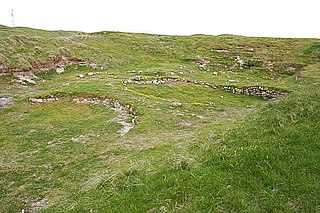 W
WCladh Hallan is an archaeological site on the island of South Uist in the Outer Hebrides in Scotland. It is significant as the only place in Great Britain where prehistoric mummies have been found. Excavations were carried out there between 1988 and 2002, indicating the site was occupied from 2000 BC.
 W
WThe conservation and restoration of human remains involves the long-term preservation and care of human remains in various forms which exist within museum collections. This category can include bones and soft tissues as well as ashes, hair, and teeth. Given the organic nature of the human body, special steps must be taken to halt the deterioration process and maintain the integrity of the remains in their current state. These types of museum artifacts have great merit as tools for education and scientific research, yet also have unique challenges from a cultural and ethical standpoint. Conservation of human remains within museum collections is most often undertaken by a conservator-restorer or archaeologist. Other specialists related to this area of conservation include osteologists and taxidermists.
 W
WDali man is the remains of a late Homo erectus or archaic Homo sapiens who lived in the late-mid Pleistocene epoch. The remains comprise a complete fossilized skull, which was discovered by Liu Shuntang in 1978 in Dali County, Shaanxi Province, China.
 W
WDetmold child is the name of a mummy found in Peru. The mummy has been identified to be about 6,500 years old, making it one of the oldest preserved mummies ever found. It was named The Detmold child by its owners Lippisches Landesmuseum in Detmold, in North Rhine-Westphalia, Germany.
 W
WThe Dmanisi skull, also known as Skull 5 or D4500, is one of five skulls discovered in Dmanisi, Georgia and classified as early Homo erectus. Described in a publication in October 2013, it is estimated to be about 1.8 million years old and is the most complete skull of a Pleistocene Homo species, and the first complete adult hominin skull of that degree of antiquity. According to researchers, the discovery "provides the first evidence that early Homo comprised adult individuals with small brains but body mass, stature and limb proportions reaching the lower range limit of modern variation."
 W
WThe Egtved Girl [ˈektveð] was a Nordic Bronze Age girl whose well-preserved remains were discovered outside Egtved, Denmark in 1921. Aged 16–18 at death, she was slim, 160 centimeters tall, had short, blond hair and well-trimmed nails. Her burial has been dated by dendrochronology to 1370 BC. She was discovered together with cremated remains of a child in a barrow approximately 30 m (98 ft) wide and 4 m (13 ft) high. Only the girl's hair, brain, teeth, nails and a little of her skin remain preserved.
 W
WThe Elling Woman is a bog body discovered in 1938 west of Silkeborg, Denmark. The Tollund Man was later discovered just c. 60 m (200 ft) away, twelve years after the Elling Woman's discovery. The Elling Woman was mistakenly described as a man in P.V. Glob's book, The Bog People, when it was published in 1965.
 W
WThe Embracing Skeletons of Alepotrypa are a pair of human skeletons dated as approximately 5,800 years old. They were discovered by archaeologists in the Alepotrypa cave in Laconia, Greece. The pair were dated to 3,800 BCE and DNA analysis confirmed that the remains belong to a man and woman who died when they were 20 to 25 years of age.
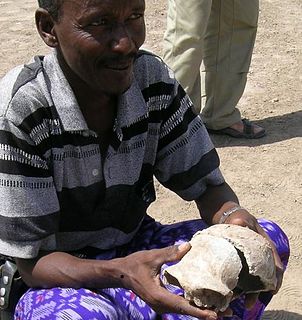 W
WThe Gawis cranium is a portion of a fossil hominin skull discovered on February 16, 2006 near the drainage of Gawis, a tributary of the Awash River in the Afar Depression, Ethiopia. Despite the presence of volcanic ash layers that are key to dating, the cranium is only generally dated between 200,000 and 500,000 years ago due to taphonomic issues.
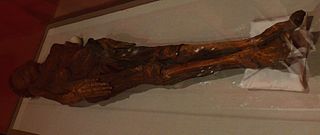 W
WGuanche mummies are the intentionally desiccated remains of members of the indigenous Berber Guanche people of the Tenerife. The Guanche mummies were made during the eras prior to Spanish settlement of the area in the 15th century. The methods of embalming are similar to those that were used by the Ancient Egyptians, though fewer mummies remain from the Guanche due to looting and desecration.
 W
WThe Hasanlu Lovers are a pair of human remains found at the Teppe Hasanlu archaeological site, located in the Solduz Valley in the West Azerbaijan Province of Iran, in 1972 by a team from the University of Pennsylvania led by Robert H. Dyson. The skeletons have been the subject of debate since they were first excavated. They were exhibited at the Penn Museum from 1974 until the mid-1980s.
 W
WHerculaneum was an ancient town, located in the modern-day comune of Ercolano, Campania, Italy. Herculaneum was buried under volcanic ash and pumice in the eruption of Mount Vesuvius in AD 79.
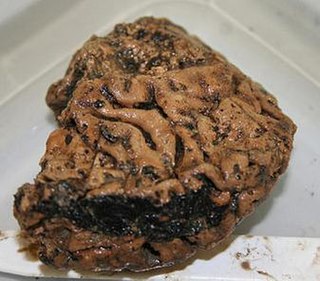 W
WThe Heslington Brain is a 2,600-year-old human brain found inside a skull buried in a pit in Heslington, Yorkshire, in England, by York Archaeological Trust in 2008. It is the oldest preserved brain ever found in Eurasia, and is believed to be the best-preserved ancient brain in the world. The skull was discovered during an archaeological dig commissioned by the University of York on the site of its new campus on the outskirts of the city of York. The area was found to have been the site of well-developed permanent habitation between 2,000–3,000 years before the present day.
 W
WHuldremose Woman, or Huldre Fen Woman, is a female bog body recovered in 1879 from a peat bog near Ramten, Jutland, Denmark. Analysis by Carbon 14 dating indicates that she lived during the Iron Age, sometime between 160 BCE and 340 CE. The mummified remains are exhibited at the National Museum of Denmark. The elaborate clothing worn by Huldremose Woman has been reconstructed and displayed at several museums.
 W
WThe Fire Mummies of the Philippines, also known as the Kabayan Mummies, Benguet Mummies, or Ibaloi Mummies, are a group of mummies found along the mountain slopes of Kabayan, a town in the northern part of the Philippines. They were made from as early as 2000 BCE. Today, they remain in natural caves and a museum in Kabayan.
 W
WThe Karsdorf remains are the bodies of more than 30 Neolithic humans who were buried in the vicinity of Karsdorf, Sachsen-Anhalt, Germany.
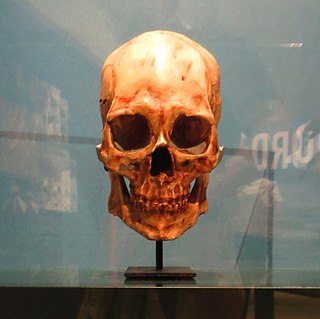 W
WKennewick Man is the name generally given to the skeletal remains of a prehistoric Paleoamerican man found on a bank of the Columbia River in Kennewick, Washington, United States, on July 28, 1996. It is one of the most complete ancient skeletons ever found. Radiocarbon tests on bone have shown it to date from 8,900 to 9,000 calibrated years before present, but it was not until 2013 that ancient DNA analysis techniques had improved enough to shed light on the remains. In June 2015, it was announced that Kennewick Man had the most genetic similarity among living peoples to Native Americans, including those in the Columbia River region where the skeleton was found.
 W
WThe Lord of Sipán is the name given to the first of several Moche mummies found at Huaca Rajada, Sipán, Peru by archaeologist Walter Alva. The site was discovered in 1987.
 W
WThe Lovers of Cluj-Napoca are a pair of human skeletons discovered in 2013 by archaeologists in the cemetery of a former Dominican convent in Cluj-Napoca, Romania. The couple are believed to have lived between 1450 and 1550 – between the year the convent was established and the year the graveyard was secularised. Analysis by archaeologists confirmed that the skeletons belong to a man and a woman around 30 years of age. The couple were buried facing each other, and with their hands interlocked.
 W
WThe 'Lovers of Modena' are a pair of human skeletons discovered in 2009 by archaeologists in present-day Modena, Italy. The two skeletons were buried with their hands interlocked and are believed to have been buried between the 4th and 6th century CE. Originally it was assumed that the two were composed of a male and a female, but upon scientific analysis of enamel peptides by the University of Bologna it was confirmed that the skeletons belong to two males. The pair are now on display at the Civic Museum of Modena.
 W
WThe Lovers of Valdaro, also known as the "Valdaro Lovers," are a pair of human skeletons dated as approximately 6,000 years old. They were discovered by archaeologists at a Neolithic tomb in San Giorgio near Mantua, Italy, in 2007. The two individuals were buried face to face with their arms around each other, in a position reminiscent of a "lovers' embrace".
 W
WThe Marmes Rockshelter is an archaeological site first excavated in 1962, near Lyons Ferry Park and the confluence of the Snake and Palouse Rivers, in Franklin County, southeastern Washington. This rockshelter is remarkable in the level of preservation of organic materials, the depth of stratified deposits, and the apparent age of the associated Native American human remains. The site was discovered on the property of Roland Marmes, and was the site of the oldest human remains in North America at that time. In 1966, the site became, along with Chinook Point and the American and English Camps on San Juan Island, the first National Historic Landmarks listed in Washington. In 1969, the site was submerged in water when a levee protecting it from waters rising behind the then newly constructed Lower Monumental Dam, which was 20 miles (32 km) down the Snake River, failed to hold back water that leaked into the protected area through gravel under the soil, creating Lake Herbert G. West.
 W
WMiguelón is the popular nickname for a human skull, classified as either late Homo heidelbergensis or as early Homo neanderthalensis. It has been estimated to date to 430,000 years ago. It is one of more than 5,500 fossils belonging to early human populations which have been found in the Sima de los Huesos site in the Sierra de Atapuerca in northern Spain.
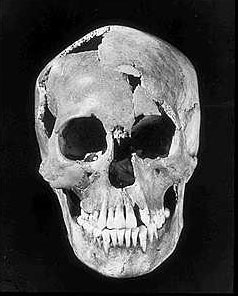 W
WMinnesota Woman, also known as Pelican Rapids-Minnesota Woman, is the skeletal remains of a woman thought to be 8,000 years old. The bones were found near Pelican Rapids, Minnesota on June 16, 1931, during construction on U.S. Route 59. The bones were brought to Albert Jenks at the University of Minnesota, who identified them as the bones of a woman who was 15 or 16 years old, but who had never borne children. The woman had two artifacts—a dagger made from an elk's horn and a conch shell pendant. The conch shell came from a whelk species known as Sinistrofulgur perversum, which had previously only been known to exist in Florida.
 W
WMomia Juanita, also known as the Lady of Ampato is the well-preserved frozen body of an Inca girl who was killed as an offering to the Inca gods sometime between 1440 and 1480 when she was approximately 12–15 years old. She was discovered on the dormant stratovolcano Mount Ampato in southern Peru in 1995 by anthropologist Johan Reinhard and his Peruvian climbing partner, Miguel Zárate. She is known as the Lady of Ampato because she was found on top of Mount Ampato. Her other nickname, the Ice Maiden, derives from the cold conditions and freezing temperatures that preserved her body on Mount Ampato.
 W
WEve of Naharon is the skeleton of a 20– to 25-year-old human female found in the Naharon section of the underwater cave Sistema Naranjal in Mexico near the town of Tulum, around 80 miles (130 km) south west of Cancún. The Naranjal subsystem is a part of the larger Sistema Ox Bel Ha. The skeleton is carbon dated to 13,600 years ago, which makes it one of the oldest documented human finds in the Americas.
 W
WNipisat Island is a small, uninhabited island in the Qeqqata municipality in central-western Greenland.
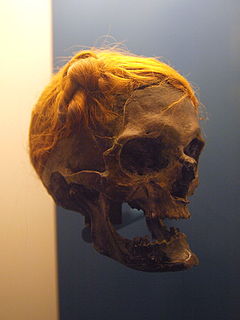 W
WOsterby Man or the Osterby Head is a bog body of which only the skull and hair survived. It was discovered in 1948 by peat cutters to the southeast of Osterby, Germany. The hair is tied in a Suebian knot. The head is at the State Archaeological Museum at Gottorf Castle in Schleswig, Schleswig-Holstein.
 W
WÖtzi, also called the Iceman, is the natural mummy of a man who lived some time between 3350 and 3105 BC, discovered in September 1991 in the Ötztal Alps on the border between Austria and Italy.
 W
WThe Plomo Mummy is the well preserved remains of an Incan child found on Cerro El Plomo near Santiago, Chile in 1954. It was discovered by Guillermo Chacón Carrasco, Jaime Ríos Abarca, and Luis Gerardo Ríos Barrueto. The mummy was brought to the attention of Grete Mostny at the Chilean National Museum of Natural History; she later proved instrumental in the museum's acquisition of the specimen. The Plomo Mummy was the first notable frozen mummy discovery of high-altitude Capacocha human sacrifice by the Incas, a practice called qhapaq hucha.
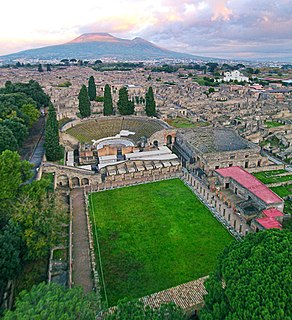 W
WPompeii was an ancient city located in what is now the comune of Pompei near Naples in the Campania region of Italy. Pompeii, along with Herculaneum and many villas in the surrounding area, was buried under 4 to 6 m of volcanic ash and pumice in the eruption of Mount Vesuvius in AD 79.
 W
WQilakitsoq is an archaeological site on Nuussuaq Peninsula, on the shore of Uummannaq Fjord in northwestern Greenland. Formally a settlement, it is famous for the discovery of eight mummified bodies in 1972. Four of the mummies are currently on display in the Greenland National Museum.
 W
WThe Saltmen were discovered in the Chehrabad salt mines, located on the southern part of the Hamzehlu village, on the west side of the city of Zanjan, in the Zanjan Province in Iran. By 2010, the remains of six men had been discovered, most of them accidentally killed by the collapse of galleries in which they were working. The head and left foot of Salt Man 1 are on display at the National Museum of Iran in Tehran.
 W
WThe Spirit Cave mummy is the oldest human mummy found in North America. It was discovered in 1940 in Spirit Cave, 13 miles (21 km) east of Fallon, Nevada, United States, by the husband-and-wife archaeological team of Sydney and Georgia Wheeler. He was said to be forty years old when he died. Analysis of the remains showed similarities to North and South American indigenous peoples and in 2016, the remains were repatriated to the Fallon Paiute-Shoshone Tribe of Nevada. The Spirit Cave mummy was one of the first to be dated using accelerated mass spectrometer radiocarbon dating. In turn, its discovery and analysis gave much insight and motivation of further research into the chronology of the western great basin.
 W
WThe Starchild skull is part of a malformed human skull of a child who likely died as a result of congenital hydrocephalus. It received widespread publicity after paranormalist Lloyd Pye claimed it was of extraterrestrial origin.
 W
WStoneyisland Man is the name given to a bog body discovered in the Stoneyisland Bog, Gortanumera, County Galway, Ireland on 13 May 1929.
 W
WTheo the Pipe Smoker is the fictitious name of a man whose skeleton was found in 1984 in a former potter's field near the Theodorskirche in Kleinbasel. He was named after the church's cemetery in which he was found.
 W
WVero man refers to a set of fossilized human bones found near Vero, Florida, in 1915 and 1916. The human bones were found in association with those of Pleistocene animals. The question of whether humans were present in Florida during the Pleistocene was controversial at the time, and most archaeologists did not accept that the Vero fossils were that old. Recent studies show that the Vero human bones are from the Pleistocene and are the largest collection of human remains from the Pleistocene found in North America.
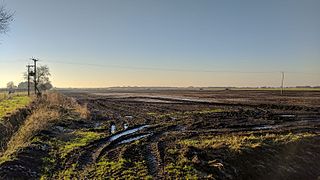 W
WChat Moss is a large area of peat bog that makes up part of the City of Salford, Metropolitan Borough of Wigan, Warrington and Trafford MBC in Greater Manchester and Cheshire England. North of the Manchester Ship Canal and River Mersey, five miles (8 km) to the west of Manchester, it occupies an area of about 10.6 square miles (27.5 km2).
 W
WThe Xiaohe Cemetery, literally "Little River Cemetery" and also known as Ördek’s Necropolis, is a Bronze Age site located in the west of Lop Nur, in Xinjiang, Western China. It contains about 330 tombs, about 160 of which were looted by grave robbers before archaeological research could be carried out.
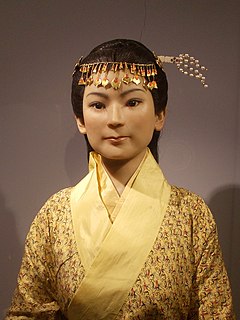 W
WXin Zhui, also known as Lady Dai or Marquise of Dai, was married to Li Cang (利蒼), the Marquis of Dai and Chancellor of Changsha Kingdom, during the Western Han dynasty of ancient China. Her tomb and exceptionally well preserved remains were discovered in 1968, alongside hundreds of valuable artifacts and documents, inside a hill known as Mawangdui, in Changsha, Hunan, China. Her body and belongings are currently under the care of the Hunan Museum, which has allowed occasional international exhibits.